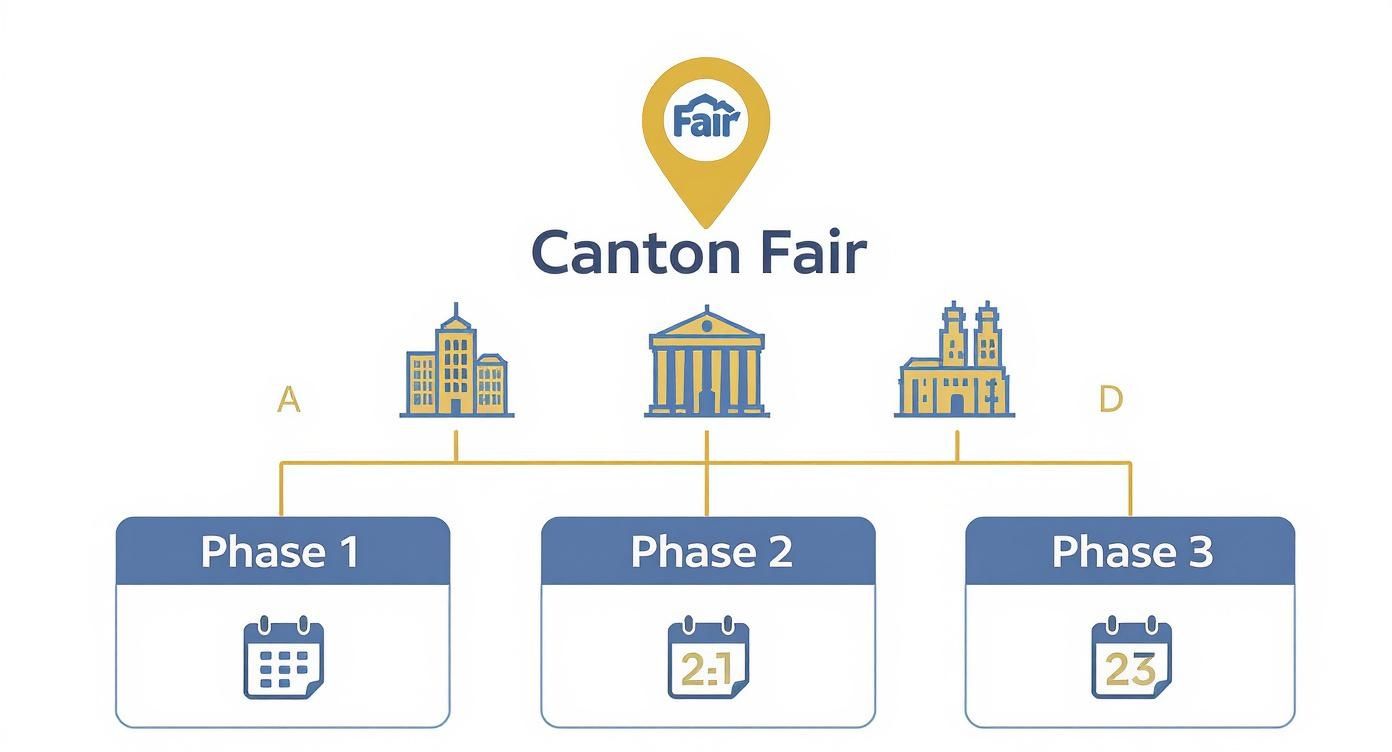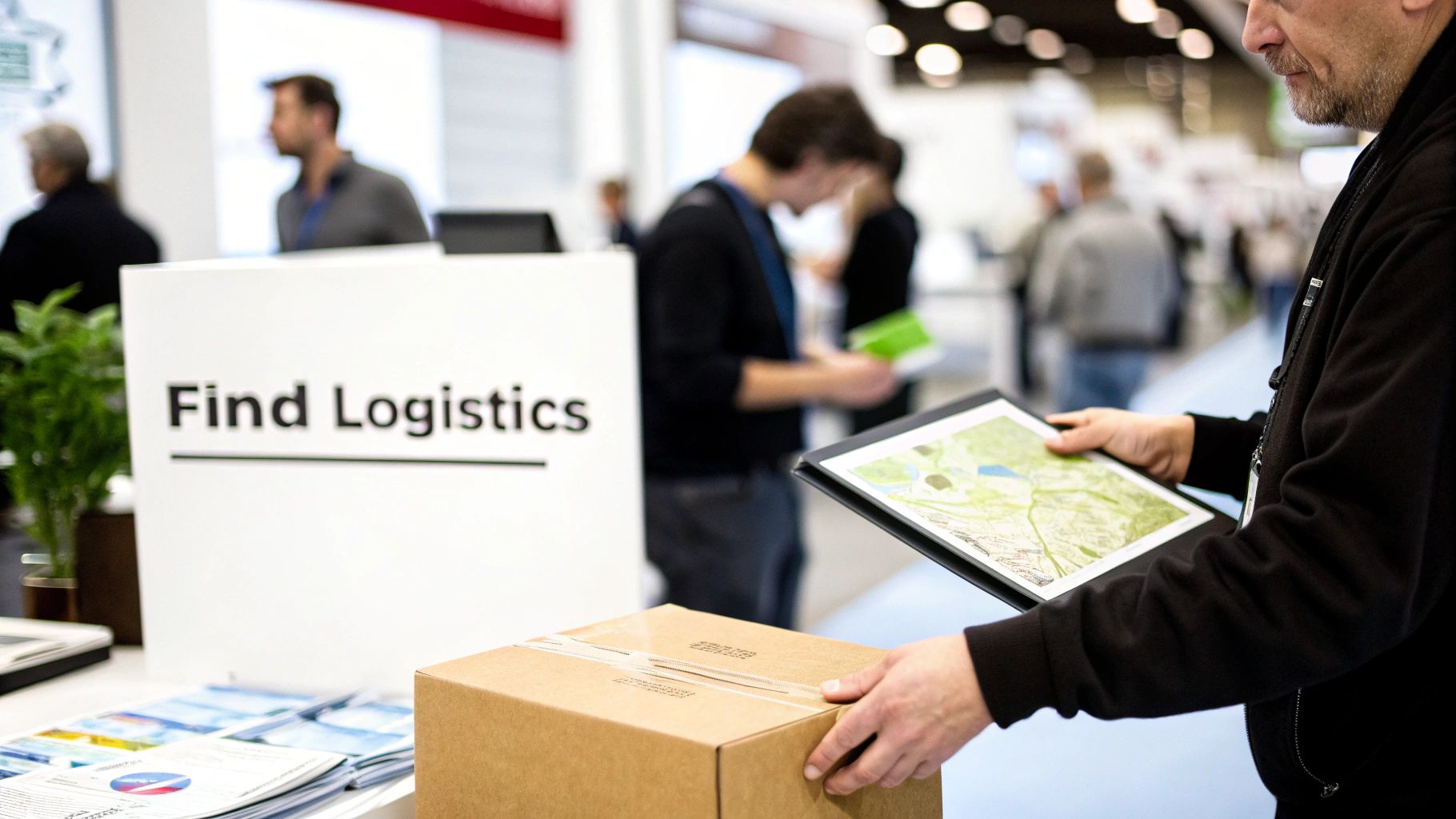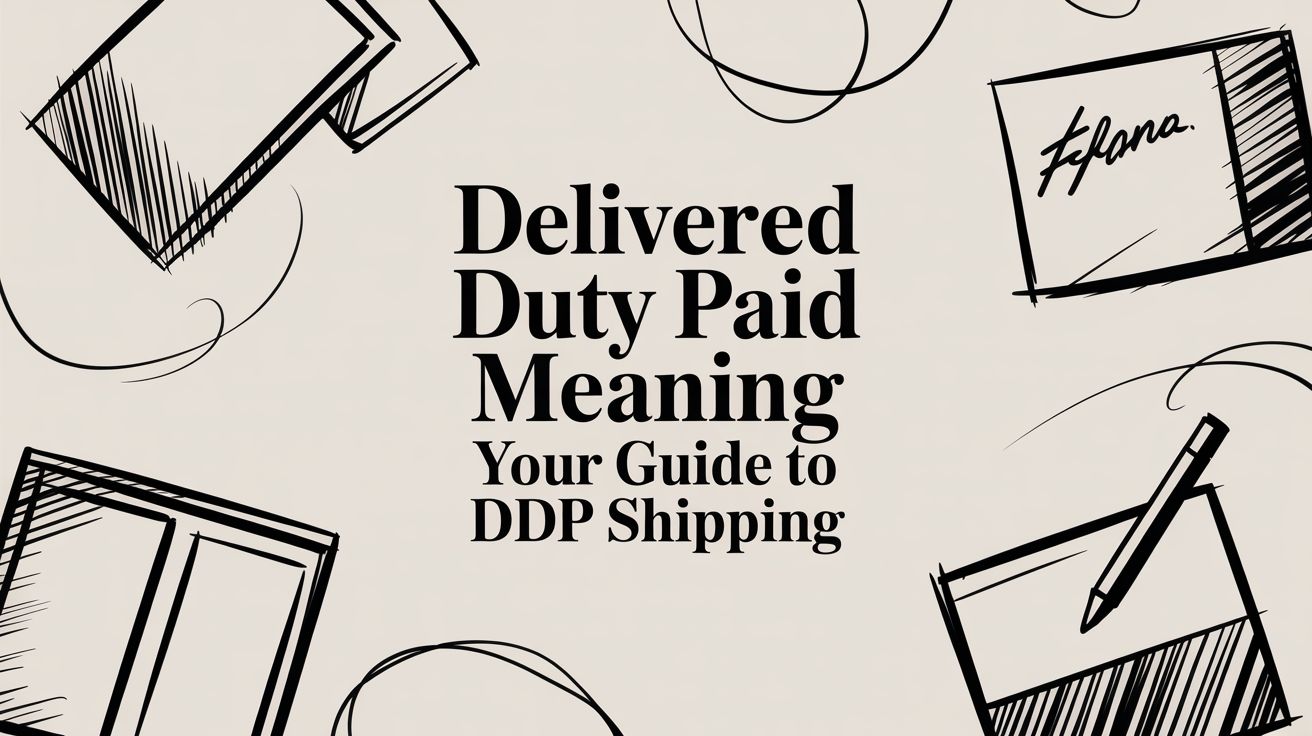The Canton Fair complex is massive. Honestly, it's less of a single building and more like its own small city. Your single most important tool for getting around isn't your phone or a good pair of shoes—it's the official Canton Fair map. Without it, you're just wandering.
Your Quick Guide to the Canton Fair Map
Trying to navigate the Canton Fair without a plan is a recipe for frustration. Imagine trying to find one specific stall in a sprawling, unfamiliar city—that's what you're up against. The place covers a staggering 1.18 million square metres, so just "winging it" is out of the question. Getting comfortable with the map is the first real step to turning an overwhelming trip into a productive sourcing mission.
The fair is cleverly broken down into three distinct phases, each running for five days and dedicated to specific industries. This setup is great because it groups similar products together, helping you focus your time and energy. Knowing which phase your products fall into is step one, even before you glance at the floor plan.
Understanding the Three Phases
Here’s the key thing to remember: the entire exhibition gets a complete reshuffle between each phase. A hall that was packed with electronics in Phase 1 could be full of home decor suppliers in Phase 2. This is why you need a phase-specific map; each one shows a unique layout for that five-day window.
The complex itself is split into four main zones: Area A, B, C, and D. Your map will show you exactly how different product categories are spread across these areas for the phase you're attending.
- Phase 1 is all about the heavy hitters: electronics, machinery, hardware, and building materials.
- Phase 2 switches gears to consumer goods, gifts, home decorations, and furniture.
- Phase 3 wraps things up with textiles, clothing, medical products, and office supplies.
A classic rookie mistake is underestimating how long it takes to get from one area to another. Walking from Area A to Area D can easily eat up more than 20 minutes. If you have back-to-back appointments, a pre-planned route based on the map isn't just helpful—it's essential.
To give you a clearer idea, let's break down how the products and areas are generally structured across the fair.
Canton Fair Phases at a Glance
This table gives you a quick snapshot of what to expect during each five-day period.
| Phase | Key Product Categories | Main Complex Areas |
|---|---|---|
| Phase 1 | Electronics, Household Appliances, Machinery, Hardware & Tools, Lighting Equipment | A, B, C, D |
| Phase 2 | Consumer Goods, Gifts & Premiums, Home Decorations, Furniture, Kitchenware | A, B, C, D |
| Phase 3 | Textiles & Apparel, Shoes, Office Supplies, Medical Devices, Food Products | A, B, C, D |
Think of this table as a general guide. The specific hall numbers for each product category can change from one fair to the next. That's why you absolutely must get your hands on the latest official Canton Fair map for your specific phase to plan your visit properly.
How to Read the Canton Fair Map
Think of the Canton Fair map as less of a simple floor plan and more of your strategic GPS for the entire event. I know, at first glance, that sea of lines, colours, and numbers can feel overwhelming. But once you crack the code, you'll be navigating the massive complex like a seasoned pro.
The entire Canton Fair Complex is basically a city in itself. To make it manageable, the map breaks it down into four huge zones: Area A, Area B, Area C, and Area D.
Picture these areas as distinct districts. Each one contains multiple exhibition halls, and they're all connected by skywalks and shuttle buses. Your first mission is to figure out which "district" your target suppliers are located in—that's the key to an efficient visit.
Decoding Hall and Booth Numbers
Okay, so you've found the right Area. Now what? The next layer is the hall number, which looks something like Hall 9.3 or Hall 11.2 on the map. These are the "neighbourhoods" within each district. For example, Hall 9.3 is a specific building inside Area B.
Inside each hall, hundreds of exhibitors are vying for your attention. This is where the booth number becomes your final destination, kind of like a specific street address. A typical booth number will read something like 9.3J25.
Let’s break that down, because it's simpler than it looks:
- 9.3: This part is the Hall Number. It tells you which building to walk into.
- J: This letter represents the Aisle or Row. Once you're inside the hall, just look up for the big signs hanging from the ceiling to find the right aisle.
- 25: This is the Booth Position Number, telling you exactly where to stop along that aisle.
Once you get this simple system, you can pinpoint any exhibitor on the map in seconds. What once looked like chaos suddenly becomes a clear, navigable grid.
This infographic gives you a great visual overview of how the phases, areas, and halls all fit together.

As you can see, the overall structure is quite logical. Each phase dictates which product categories are on display across the four main areas, helping you focus your time.
Identifying Key Symbols and Amenities
A truly useful map does more than just show you where the booths are—it helps you survive the marathon that is the Canton Fair. The official map is packed with symbols that point you to crucial on-site services. Spotting these quickly will save you a ton of time and hassle.
Before you dive in, take a minute to study the map's legend. This little key unlocks everything.
Keep an eye out for these essentials:
- Information Desks: Usually found near the main entrances, these are your lifeline for any questions or printed guides.
- Restrooms: A simple but vital piece of information. Knowing where the nearest ones are is non-negotiable.
- Food Courts & Cafes: Pinpoint the dining spots in the areas you'll be visiting so you can plan your breaks strategically.
- Shuttle Bus Stops: These are absolutely critical for moving between the massive areas without walking for an hour. The map shows you exactly where they are and which routes they run.
- Prayer Rooms & Business Centres: The fair is well-equipped with dedicated spaces for all sorts of attendee needs.
Pro Tip: Do yourself a huge favour and download the official map from the Canton Fair website or their app before you even leave your hotel. You can start highlighting your must-visit booths and planning your route, which will save you precious time on the exhibition floor.
By getting familiar with these symbols, your map becomes more than just a floor plan. It's a complete guide for your day. You can plan not just your supplier meetings, but also your lunch, your coffee breaks, and your travel time between halls. This kind of preparation is what separates the seasoned veterans from the overwhelmed first-timers.
Planning Your Visit with the Map
Let’s be honest: showing up to the Canton Fair without a plan is a recipe for disaster. With a venue that covers more than a million square metres, just wandering in is like trying to navigate the ocean without a compass. This is where the Canton Fair map becomes your most important tool. It’s what turns a chaotic, exhausting trip into a precise, targeted sourcing mission.
Think of it as the key to converting days of endless walking into a series of productive, back-to-back meetings. The real work actually starts long before you ever step foot inside the complex. Your first port of call should be the official Canton Fair online directory, where you'll find a complete list of every exhibitor, their products, and, crucially, their booth numbers.

Building Your Supplier Hit List
First things first, create your "must-see" list. These are the exhibitors whose products are a perfect match for what you're looking for. But don't just stop there. It's also smart to have a secondary "nice-to-see" list for suppliers who look promising but aren't your absolute top priority.
For every single supplier on your lists, jot down their full booth number—something like 10.3 G09. This is your destination. With this information in hand, you can start plotting these locations directly onto your map, whether you're using a paper copy or a digital version.
A well-prepared map is a genuine game-changer. Marking each booth gives you a visual blueprint for your day. You’ll instantly spot clusters of suppliers in the same hall or area, making it obvious which route is the most logical and efficient.
Creating a Logical Walking Path
Once you’ve dotted your map with your targets, the overwhelming scale of the fair suddenly starts to look manageable. Instead of zig-zagging back and forth across the enormous grounds, you can now map out a route that saves you hours of backtracking and, more importantly, conserves your energy for the actual negotiations.
Here’s a simple, step-by-step way to plan your path:
- Group by Area: Look at all your marked booths and group them by their main area (A, B, C, or D). Try to dedicate a full day or at least half a day to a single area to avoid trekking across the entire complex.
- Cluster by Hall: Now, zoom in on each area. Do you have several targets in Hall 9.3? Plan to hit all of them before you even think about moving on to Hall 10.3.
- Sequence Your Appointments: Arrange your meetings in order based on booth locations. This lets you flow seamlessly from one supplier to the next without constantly retracing your steps.
This kind of methodical planning is what separates the pros from the amateurs. To build effective trade show marketing strategies that utilize the convention map, you have to think like a logistics expert, making every minute and every step count. This prep work ensures you spend your time talking business, not staring at signs wondering where you are.
Maximising Your Time with Themed Days
Here’s a tip seasoned buyers swear by: theme your days. If you're sourcing a mix of products, you could dedicate Monday morning to electronics in Area A and the afternoon to home textiles over in Area C. Knowing the https://upfreights.com/blog/top-product-categories-to-source-from-china can really help you structure this effectively. A focused approach like this helps keep your mind sharp and your conversations on point.
When you use the Canton Fair map as the foundation of your itinerary, you take an overwhelming experience and turn it into a controlled, highly effective business trip. Your map is no longer just a guide; it’s your battle plan for sourcing success.
Using the Map for On-Site Logistics
Think of your Canton Fair map as more than just a tool for finding exhibitors—it's your command centre for on-site logistics. After you’ve shaken hands on a great deal, the very next thought is, "How do I get this home?" This is the moment your map becomes absolutely essential for getting samples and small orders out of the fair and on their way.
The scale of the Canton Fair is immense. At recent events, a staggering 289,000 foreign buyers from 219 countries and regions flooded the halls. With that many people and that much product moving, knowing exactly where to go for logistical support isn't just helpful; it's a necessity.

Pinpointing Essential Services on Your Map
Before you even step into a hall for the day, spend a few minutes with your map. Your goal is to find and circle the logistics hubs. These are the service points that will save you a ton of hassle when you've collected samples you can't carry or placed a small trial order.
Check the map's legend for these key spots:
- Courier Service Points: Big names like DHL, FedEx, and UPS have booths right there on-site. Marking their locations means you can quickly send off small, time-sensitive samples without a second thought.
- Logistics Company Booths: Freight forwarders, including Upfreights, are often present at the fair. These are the go-to spots for discussing larger shipment options, grabbing a quick quote, and arranging future collections.
- Official Collection and Loading Points: These are the designated zones where goods are officially handed over for shipping. Knowing where they are saves you from wandering around with heavy boxes, searching for a pickup spot.
The more you plan your logistical moves, the more time you free up to build relationships and master trade show lead generation, which is the real reason you're there.
The Sample Handoff: A Step-by-Step Workflow
So, you’ve just found the perfect product in Area B and the exhibitor has given you a few excellent samples. What now? Instead of lugging them around all day, you can set a smooth handoff in motion right from their booth.
Here's how that usually works:
- Arrange Pickup with the Exhibitor: First, just ask the supplier if they can hold onto the samples for a logistics partner to collect. Almost all of them are used to this and are happy to help.
- Contact Your Logistics Provider: Next, send a quick message to your shipping partner. Tell them exactly where the booth is (something like, "Hall 10.3, Booth F12") and what needs picking up.
- Coordinate a Time: Agree on a pickup window. This might be at the end of the day or during a quieter period, giving the exhibitor time to pack everything up for you.
- Confirm the Handoff: Finally, make sure your logistics provider sends you a confirmation once they have the items. This little update gives you peace of mind to get back to business without being weighed down.
By circling the logistics services on your map beforehand, you can coordinate this entire process from your phone while standing at the exhibitor's booth. That kind of efficiency is what separates a stressful trip from a truly productive one.
From Fairground to Freight Forwarder
When you're dealing with larger sample collections or small orders placed at the fair, the process scales up a bit. This is where the designated loading zones become important. These are specific areas set up for freight forwarders to bring in vehicles and manage collections in an organised way.
Your Canton Fair map will point you to these loading areas, which are usually located on the outer edges of the main exhibition halls for easier vehicle access. Knowing their locations in advance is crucial for coordinating with a professional freight service like Upfreights. You can arrange a complete service that handles everything from consolidation to final delivery. Upfreights makes it simple, offering seamless door-to-door shipping from China that turns what you found at the fair into inventory in your warehouse.
At the end of the day, using your map for logistics is all about planning ahead. It transforms the overwhelming task of moving goods out of a massive exhibition into a simple, predictable series of steps.
Streamlining Your Shipping Process
Sourcing great products at the Canton Fair is a huge win, but it's really just the first step. Now comes the real challenge: getting everything from the bustling exhibition floor all the way back to your warehouse. This part can feel overwhelming, but if you've done your homework with the Canton Fair map, you've already laid the groundwork for a surprisingly smooth shipping process.
The journey from a handshake deal to a delivered container really boils down to one core concept: consolidation. Let’s be realistic—you’re probably not sourcing from just one supplier. Trying to manage a bunch of small, separate shipments from different factories is a logistical nightmare and a surefire way to blow your budget. The smart move is to group all your purchases together before they even think about leaving China.
From Multiple Booths to a Single Shipment
Picture this: you've struck gold with three different suppliers, one in Area A, another in B, and a third over in D. The most efficient way to handle this is to have all those orders sent to one central spot—usually your freight forwarder's warehouse in or near Guangzhou. From there, you can combine everything into a single, larger shipment, whether that’s a Less than Container Load (LCL) or a Full Container Load (FCL).
Why go to all this trouble? The benefits are huge.
- Massive Cost Savings: Shipping one big box is almost always cheaper than shipping several small ones. You'll save on everything from local trucking to port fees and customs charges.
- Less Headaches: You only have one shipment to track and one set of paperwork to worry about. This alone makes the entire process far less complicated.
- Better Security: Funnelling everything through a secure warehouse drastically reduces the chances of products getting lost or damaged during a series of messy handoffs.
The Role of an On-Site Logistics Partner
This is exactly where a good freight forwarder proves its worth. Since you’ve already marked out the logistics providers on your map, you can walk right up and talk to them at the fair. A partner like Upfreights can step in and coordinate the entire pickup schedule from each of your suppliers' factories once the fair wraps up.
The Canton Fair is more than just a trade show; it's a powerful indicator of global trade trends. In fact, recent figures show a significant 8.2% jump in buyers from the US and Europe, bringing their total attendance to 54,000. This isn't just a number—it highlights the fair's enduring importance and the growing demand for reliable shipping to handle all that new business. You can dive deeper into these trends and China's trade ecosystem on english.scio.gov.cn.
When you work with a single logistics partner, you hand off all the complex moving parts. They’ll be the ones talking to each supplier, arranging the trucks to bring everything to their warehouse, and prepping it all for the international leg of the journey. If you're wondering what to look for, our guide on how to choose a freight forwarder in China is a great place to start.
The Final Leg of the Journey
Once all your goods are safely consolidated, the final part of the shipping process kicks off. Your logistics partner takes over the critical tasks—clearing export customs, booking space on a ship or plane, and handling the mountain of necessary paperwork. From their warehouse, your now-combined shipment is moved to a major port like Guangzhou, Shenzhen, or Hong Kong, ready for its trip across the ocean.
The workflow is pretty straightforward and built for efficiency:
- Supplier Pickups: Your forwarder arranges to collect the finished goods from each factory.
- Warehouse Consolidation: Everything arrives at a secure facility where it's checked and packed together.
- Customs and Booking: They handle the export paperwork and secure a spot on the vessel or aircraft.
- International Shipping: The container is loaded for sea freight, or the pallets are prepared for air freight.
- Final Delivery: Once it arrives in your country, it clears import customs and is delivered right to your door.
This structured approach, which all began with a little bit of smart planning back at the fair, turns a potentially chaotic puzzle into a clear, predictable, and manageable operation.
Got Questions About the Canton Fair Map? We've Got Answers
To make sure you hit the ground running, let's tackle some of the most common questions that pop up when navigating the Canton Fair. Think of this as your practical cheat sheet for getting around the complex like a seasoned pro.
Where Can I Get an Official Canton Fair Map?
You've got a few great options, and honestly, using a mix of them is the smartest way to go.
Before you even pack your bags, head over to the official Canton Fair website. You can download a PDF of the map for your specific phase, which is perfect for sketching out a rough plan of attack.
Once you're there, the official Canton Fair mobile app has a fantastic interactive map for real-time navigation. But for those of us who've been saved by a paper backup one too many times, you'll find free printed maps at the information desks near the main entrances. I always grab one—you never know when your phone battery might decide to call it a day.
Is the Map the Same for All Three Phases?
This is a big one, and it catches a lot of newcomers out. The physical layout of the complex—Areas A, B, C, and D—doesn't change. But what's inside them does, completely.
Each phase has a totally different set of exhibitors and product categories. A hall that's buzzing with electronics in Phase 1 might be full of home textiles in Phase 3. So, the map and exhibitor directory are unique to each phase. If you're attending more than one, you must grab the right map for each. Trying to use a Phase 1 map during Phase 2 is a recipe for getting lost and frustrated.
Key Takeaway: Always, always double-check that your map matches the phase you're in. Your entire plan for the day hinges on having the right information.
The fair has grown immensely since it started back in 1957. It’s now China's top trade event, with recent sessions in 2025 drawing over 280,000 international buyers. That incredible scale is exactly why having the correct, phase-specific map is non-negotiable. You can read more about the fair's impressive journey and the Canton Fair's development on zhujianger.com.
How Do I Find a Specific Exhibitor on the Map?
Finding a supplier is actually pretty simple once you crack the code on their booth number. First, find the exhibitor in the official directory (either online or the physical guide). You'll see a booth number that looks something like 9.3J25.
That code is your treasure map. Let's break it down:
- 9.3: This is your Hall Number. The first thing you'll do is find Hall 9.3 on the main map.
- J: This letter is the Aisle or Row. Once you're inside the hall, look up. You'll see big signs hanging from the ceiling pointing you to the right aisle.
- 25: This is the specific Booth Number on that aisle. They run in order, so it’s easy to spot.
By plotting these "coordinates" on your map before you start your day, you can create a logical route that gets you from one meeting to the next without wandering around in circles.
Are There Shuttle Buses Between Different Areas?
Yes, and they are an absolute godsend. The Canton Fair complex is massive. Walking from Area A to Area D can easily take over 20 minutes, and that's walking with a purpose.
To save your feet and your energy, the fair runs a fleet of free electric shuttle buses. They travel along set routes connecting all the main areas, and the stops are clearly marked on every official map.
My advice? Use them. Don't try to be a hero and walk everywhere. Hopping on a shuttle lets you save your energy for what you're really there for: finding great products and talking business with suppliers. Factoring in a bit of shuttle time is a veteran move that will keep you fresh all day long.
Article created using Outrank



